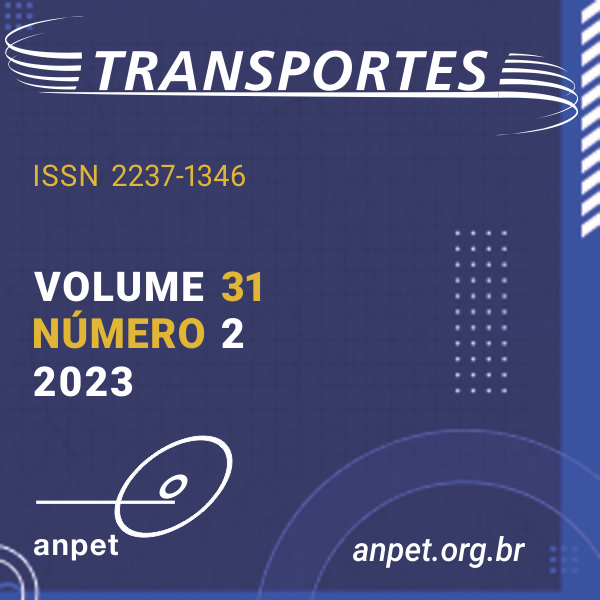Desenvolvimento de modelos de previsão de coeficiente de atrito em pistas de pouso e decolagem brasileiras com Redes Neurais Artificiais
DOI:
https://doi.org/10.58922/transportes.v31i2.2792Palavras-chave:
Pavimentos aeroportuários, Resistência à derrapagem, Coeficiente de atrito, Segurança operacionalResumo
As operações de pouso e decolagem representam as fases mais críticas de um voo, uma vez serem suscetíveis a diversos fatores que intervêm em seu desempenho, tais como a habilidade do piloto, as condições climáticas e de aderência pneu-pavimento. Nesse contexto, o coeficiente de atrito representa um parâmetro importante para a segurança operacional no quesito aderência pneu-pavimento. Dessa forma, esta pesquisa visa desenvolver modelos de previsão utilizando Redes Neurais Artificiais para o coeficiente de atrito medido a 3 e a 6 metros do eixo de pistas de pouso e decolagem (PPD) por meio de diferentes tipos de equipamento com a finalidade de auxiliar o operador de aeródromo quanto à garantia da segurança operacional, além de verificar a influência do grooving no desempenho do coeficiente de atrito. Os modelos desenvolvidos apresentaram resultados satisfatórios dada a complexidade do problema, demonstrando que, apesar de necessitar de aprimoramentos futuros, eles podem contribuir com a segurança das operações nas PPD.
Downloads
Referências
Abiodun, O.I.; A. Jantan; A.E. Omolara et al. (2018) State-of-the-art in artificial neural network applications: a survey. Heliyon, v. 4, n. 11, p. E00938. DOI: 10.1016/j.heliyon.2018.e00938. DOI: https://doi.org/10.1016/j.heliyon.2018.e00938
ANAC (2019) RBAC 153: Aeródromos - Operação, Manutenção e Resposta à Emergência. Emenda nº 4. Brasília: Agência Nacional de Aviação Civil.
ANAC (2021) Consulta Interativa – Indicadores do Mercado de Transporte Aéreo. Brasília: Agência Nacional de Aviação Civi.
Anupam, K.; S.K. Srirangam; A. Scarpas et al. (2013) Influence of temperature on tire-pavement friction analyses. Transportation Research Record, v. 2369, n. 1, p. 114-124. DOI: 10.3141/2369-13. DOI: https://doi.org/10.3141/2369-13
Aps, M. (2006) Classificação da Aderência Pneu-Pavimento Pelo Índice Combinado IFI – International Friction Index para Revestimentos Asfálticos. Thesis (Ph.D.). Escola Politécnica, Universidade de São Paulo, São Paulo, SP. DOI: 10.11606/T.3.2006.tde-11122006-144825 DOI: https://doi.org/10.11606/T.3.2006.tde-11122006-144825
Bocanegra, C.W.R. (2002) Procedimentos para Tornar Mais Efetivo o Uso das Redes Neurais Artificiais em Planejamento de Transportes. Dissertation (master of science). Escola de Engenharia de São Carlos, Universidade de São Paulo, São Carlos, SP. DOI: 10.11606/D.18.2002.tde-06032002-131951. DOI: https://doi.org/10.11606/D.18.2002.tde-06032002-131951
Bosurgi, G. and F. Trifirò (2005) A model based on artificial neural networks and genetic algorithms for pavement maintenance management. International Journal of Pavement Engineering, v. 6, n. 3, p. 201-209. DOI: 10.1080/10298430500195432. DOI: https://doi.org/10.1080/10298430500195432
Chelliah, T.; P. Stephanos; T. Smith et al. (2002) Developing a design policy to improve pavement surface characteristics. In Transportation Research Board (ed.) Pavement Evaluation Conference. Location: Transportation Research Board, p. 1-19.
Chen, J.S.; C.C. Huang; C.H. Chen et al. (2008) Effect of rubber deposits on runway pavement friction characteristics. Transportation Research Record, v. 2068, n. 1, p. 119-125. DOI: 10.3141/2068-13. DOI: https://doi.org/10.3141/2068-13
Costa, S.L.; V.T.F. Castelo Branco and E.F. Freitas (2017) Avaliação da aderência pneu-pavimento para diferentes tipos de pavimentos utilizando o International Friction Index (IFI). In Associação Nacional de Pesquisa e Ensino em Transporte (org.) XXXI Congresso da Associação Nacional de Pesquisa e Ensino em Transporte. Recife: ANPET, p. 1-12.
Domitrovic, J.; T. Rukavina and H. Dragovan (2018) Application of an artificial neural network in pavement management system. Technical Gazette, v. 25, p. 466-473. DOI: 10.17559/TV-20150608121810. DOI: https://doi.org/10.17559/TV-20150608121810
Flintsch, G.W.; J.P. Zaniewski and J. Delton (1996) Artificial neural network for selecting pavement rehabilitation projects. Transportation Research Record, v. 1524, n. 1, p. 185-193. DOI: 10.1177/0361198196152400122. DOI: https://doi.org/10.1177/0361198196152400122
Flintsch, G.W.; Y. Luo and I.L. Al-Qadi (2005) Analysis of the effect of pavement temperature on the frictional properties of flexible pavement surfaces. In Transportation Research Board (org.) 84th Transportation Research Board Annual Meeting. Washington, D.C.: Transportation Research Board.
Fonseca, O.A. (1990) Manutenção de Pavimentos de Aeroportos. Brasília: Diretoria de Engenharia da Aeronáutica/Divisão de Estudos e Projetos de Infraestrutura/Ministério da Aeronáutica.
Fwa, T.F.; W.T. Chan and C.T. Lim (1997) Decision framework for pavement friction management of airport runways. Journal of Transportation Engineering, v. 123, n. 6, p. 429-435. DOI: 10.1061/(ASCE)0733-947X(1997)123:6(429). DOI: https://doi.org/10.1061/(ASCE)0733-947X(1997)123:6(429)
Géron, A. (2017) Hands-on Machine Learning with Scikit-learn & TensorFlow. Sebastopol: O’Reilly.
Haykin, S. (2009) Neural Networks and Learning Machines (3rd ed.). Upper Saddle River, NJ: Pearson.
Hossain, M.I.; L.S.P. Gopisetti and M.S. Miah (2019) International roughness index prediction of flexible pavements using neural networks. Journal of Transportation Engineering, Part B: Pavements, v. 145, n. 1, p. 04018058. DOI: 10.1061/JPEODX.0000088. DOI: https://doi.org/10.1061/JPEODX.0000088
ICAO (2019) State of Global Aviation Safety: Safety Report. Montreal: International Civil Aviation Organization.
Kazda, A. and R.E. Caves (2007) Airport Design and Operation (2nd ed). New York: Elsevier Science.
Masad, E.; A. Rezaei; A. Chowdhury et al. (2009) Predicting Asphalt Mixture Skid Resistance Based on Aggregate Characteristics. Austin: Texas Transportation Institute. Available at: <https://static.tti.tamu.edu/tti.tamu.edu/documents/0-5627-1.pdf > (accessed 03/17/2023).
McDaniel, R.S.; K.J. Kowalski; A. Shah et al. (2010) Long Term Performance of a Porous Friction Course. West Lafayette: Taylor & Francis Online. DOI: https://doi.org/10.5703/1288284314284
Najafi, S.; G.W. Flintsch and S. Khaleghian (2019) Pavement friction management – artificial neural network approach. International Journal of Pavement Engineering, v. 20, n. 2, p. 125-135. DOI: 10.1080/10298436.2016.1264221. DOI: https://doi.org/10.1080/10298436.2016.1264221
Oliveira, P.V.S. (2017) Estudo Preliminar do Comportamento da Capacidade de Atrito nas Pistas de Pouso e Decolagem do Aeroporto Pinto Martins. Undergraduate thesis (bachelor degree). Universidade Federal do Ceará, Fortaleza, CE. Available at: <http://www.repositorio.ufc.br/handle/riufc/29491> (accessed 03/17/2023).
Quariguasi, J.B.F.; F.H.L. Oliveira and S.D.S. Reis (2021) A prediction model of the coefficient of friction for runway using artificial neural networks. Transportes, v. 29, n. 2, p. 2401. DOI: 10.14295/transportes.v29i2.2401. DOI: https://doi.org/10.14295/transportes.v29i2.2401
Ribeiro, A.J.A.; C.A.U. Silva and S.H.D.A. Barroso (2018) Metodologia de baixo custo para mapeamento geoté cnico aplicado à pavimentação. Transportes, v. 26, n. 2, p. 84-100. DOI: 10.14295/transportes.v26i2.1491. DOI: https://doi.org/10.14295/transportes.v26i2.1491
Santos, A.; E. Freitas; S. Faria et al. (2014) Degradation prediction model for friction in highways. In Murgante, B.; S. Misra; A.M.A.C. Rocha et al. (eds.) Computational Science and Its Applications - ICCSA 2014 14th International Conference, Guimarães, Portugal, June 30 - July 3, 204, Proceedings, Part III. Cham: Springer, p. 606-614. DOI: 10.1007/978-3-319-09150-1_44. DOI: https://doi.org/10.1007/978-3-319-09150-1_44
Shahin, M.Y. (2005) Pavement Management for Airports, Roads, and Parking Lots (2nd ed). New York: Springer
Skerritt, W.H. (1993) Aggregate type and traffic volume as controlling factors in bituminous pavement friction. Transportation Research Record, v. 1418, p. 22-29.
Susanna, A.; M. Crispino; F. Giustozzi et al. (2017) Deterioration trends of asphalt pavement friction and roughness from medium-term surveys on major Italian roads. International Journal of Pavement Research and Technology, v. 10, n. 5, p. 421-433. DOI: 10.1016/j.ijprt.2017.07.002. DOI: https://doi.org/10.1016/j.ijprt.2017.07.002
Thube, D.T. (2012) Artificial Neural Network (ANN) based pavement deterioration models for low volume roads in India. International Journal of Pavement Research and Technology, v. 5, n. 2, p. 115-120.
Yao, L.; Q. Dong; J. Jiang et al. (2019) Establishment of prediction models of asphalt pavement performance based on a novel data calibration method and neural network. Transportation Research Record, v. 2673, n. 1, p. 66-82. DOI: 10.1177/0361198118822501. DOI: https://doi.org/10.1177/0361198118822501
Downloads
Publicado
Como Citar
Edição
Seção
Licença
Copyright (c) 2023 Túlio Rodrigues Ribeiro, Francisco Heber Lacerda de Oliveira

Este trabalho está licenciado sob uma licença Creative Commons Attribution 4.0 International License.
Ao submeter um manuscrito para publicação neste periódico, todos os seus autores concordam, antecipada e irrestritamente, com os seguintes termos:
- Os autores mantém os direitos autorais e concedem à Transportes o direito de primeira publicação do manuscrito, sem nenhum ônus financeiro, e abrem mão de qualquer outra remuneração pela sua publicação pela ANPET.
- Ao ser publicado pela Transportes, o manuscrito fica automaticamente licenciado sob a Licença Creative Commons CC BY 4.0. Esta licença permite o seu compartilhamento com reconhecimento da autoria e da publicação inicial neste periódico.
- Os autores têm autorização para assumir contratos adicionais separadamente, para distribuição não exclusiva da versão do trabalho publicada neste periódico (por ex.: publicar em repositório institucional ou como capítulo de livro), com reconhecimento da publicação inicial na Transportes, desde que tal contrato não implique num endosso do conteúdo do manuscrito ou do novo veículo pela ANPET.
- Os autores têm permissão e são estimulados a publicar e distribuir seu manuscrito online (por ex.: em repositórios institucionais ou na sua página pessoal) depois de concluído o processo editorial. Como a Transportes é de acesso livre, os autores são estimulados a usar links para o DOI do artigo nesses casos.
- Os autores garantem ter obtido a devida autorização dos seus empregadores para a transferência dos direitos nos termos deste acordo, caso esses empregadores possuam algum direito autoral sobre o manuscrito. Além disso, os autores assumem toda e qualquer responsabilidade sobre possíveis infrações ao direito autoral desses empregadores, isentando a ANPET e a Transportes de toda e qualquer responsabilidade neste sentido.
- Os autores assumem toda responsabilidade sobre o conteúdo do manuscrito, incluindo as devidas e necessárias autorizações para divulgação de dados coletados e resultados obtidos, isentando a ANPET e a Transportes de toda e qualquer responsabilidade neste sentido.










